The Imperial Malaia Garnet story is told in letters below from All That Glitters to GIA, as well as in the related article published by GIA.
First letter to GIA accompanying the Imperial Malaia gemstone for the G&G article. The term Imperial Malaia Garnet is first used here. View Letter
The Gems & Gemology GIA article showing the original
gemstone from All That Glitters can be viewed below:
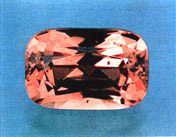 View Article
View Article
A newer garnet (1998 timeframe) is also seen being sold as Imperial Garnet, and is similar in some ways to Imperial Malaia Garnet, but different enough that I would call it simply Imperial Malaia Garnet Type II - good stones of this Imperial Garnet are not common, but less rare than the Imperial Malaia Garnet described in the G&G article. The major difference being a lower RI value (this might vary slightly), the lack of strong anomalous refraction and the material seems to come slightly cleaner and larger. The material seems to be dichoic, a similar property to the original Imperial Malaia Garnet find. In the letter below, we describe what we have learned and also mention Champagne Garnet, which is a beige or tan garnet without similar properties to either Imperial Malaia Garnet or Imperial Malaia Garnet Type II. View Letter
We had been essentially the sole purchaser of this material, with a few exceptions. The exceptions would be the importer who obtained the rough from the person digging in Madagascar and one rough dealer. All this material dried up shortly after our original purchase of a few pieces of larger rough. We have had very few stones over the past 5 years (2003 timeframe) though we have constantly attempted to obtain more from the source. As of 2014, we haven't seen anything that really seemed to be Imperial Malaia Garnet in the rough or faceted, though a few dealers abroad have labeled their garnets as Imperial Malaia.
Note that the stones look dichroic (two distinct colors displaying within the stone - the property is not very evident in these photos).Thisdichroic property is impossible because of the physical property of garnets.There are some gemstones, however, that "seem" to be dichroic - this is due to strong anomalous refraction and this is one of the reasons why this find is unique. Also note that there is a strong color shift from typically a very pale orange, pink or beige/tan, to intense pink, pinkish red, orange, reddish orange, peachy orange, etc. Since light sources typically contain many wavelenths and many rooms contain different light sources, these stones will typically show many different colors at the same time. Truly, a unique gemstone rarity. We know of no other companies currently selling this material.
| Color Comparison of same stone-different lights | |
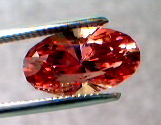 |
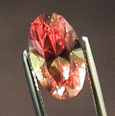 |
| Note the color shift of
the 1.93ct Oval Imperial Malaia Garnet. The
picture on the right shows more of the
pseudo-dichroism. Depending on the light, the
stone maybe more orange, peach or red; perhaps all
colors at the same time too! (SOLD!) |
|
| In certain lights, this looks light it "could" be Imperial Malaia" - but it's not.... |
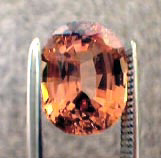 |
| Though this has the orange component and a slight dichroic look, this is NOT Imperial Malaia Garnet due to a number of missing physical properties. The color is reminiscent of Imperial Malaia - note that the actual stone in person appears more peach, but does pick up the reddish overtones as does the Imperial Malalia pictured above when photographed under the same lights and with the same camera. (SOLD!) |
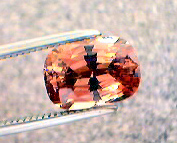 |
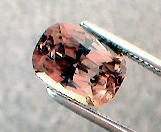 |
|
Fluorescent Lights
|
Incandescent
|
|
1.56ct Elongated Cushion
Imperial Malaia Garnet
|
|
| This rare and seldom seen material was brought to the trade's attention by L. Allen Brown of All That Glitters in 1996. All That Glitters has been the sole seller of this material - we do not know of any others who have this rare gemstone. Unfortunately, this is so rare that only a few gems are produced. Currently, due to the rarity, it it not worth the time and effort to mine this material - sapphires have commanded more attention vs. finding a rarity after toiling for perhaps months... (SOLD!) | |
Once again, this material is no longer available. We hope to have a few pieces sporadically. Do not expect anything new as miners are mining sapphires and don't have an interest in garnets, regardless of how rare they are.The miners find it more profitable to mine sapphires than to look for a rare garnet for months and never find anything! If you are interested in this material, please feel free to send us an email to have your name added to the list of those currently waiting. Prices for stones of slightly larger or smaller than 1 carat are running approximately $250-350 per carat, which for the money, is a steal since other garnets such as regular Malaia, Spessartites, etc. are frequently priced higher! These gemstones are far more rare than Alexandrite.......
We have seen a number of companies selling Garnets as Imperial Malaia. They would fall into another category of perhaps Champagne or Malaia, but not the Imperial Malaia category/group. It is most likely a designation for a higher asking price. The Garnet Group is very diverse and many tests have to be performed in order to find out what group a Garnet may belong to. Some of these tests, especially where elemental percentages are examined, have to be performed in a laboratory environment with instruments costing millions of dollars. This is frequently by-passed due to cost and items may be identified by sight. For the Garnet Group, this may not be sufficient to determine which group a Garnet falls into, and that might also be sufficient depending on one's goal.
We do occasionally have similarly colored garnets and they may exhibit a color shift similar to the Imperial Malaia.
Depending on the color, we will call them Imperial or Champagne Garnets and they are beautiful in their own right.
Larger gems are not common. You can check our inventory for Imperial/Champagne Garnets on the following photo pages:
Garnets
Color Change Garnets
Visit our other Garnet Inventory Pages to view more photos of the Garnet Group:
Miscellaneous Garnets - May not displayed on the pages below
Color Change/Color Shifting Garnet
Mahenge (New Location/Colors Create Demand)
Spessartite (Orange)
Demantoid (Green Andradite)
Tsavorite (Green Grossular)
Imperial, Imperial Malaya, Champagne or similar